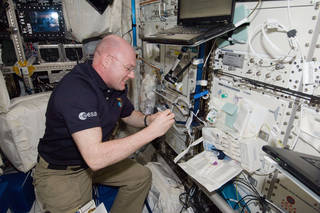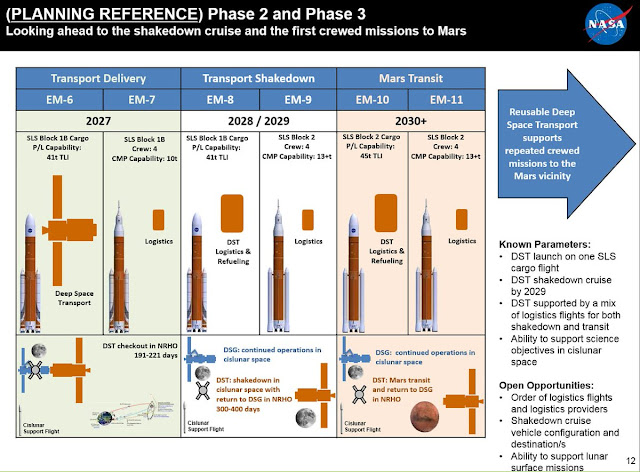 |
| An artist's conception of the Deep Space Gateway, intended to gain experience in cislunar orbit, operating near an Orion crew vehicle (NASA illustration). |
The National Aeronautics and Space Administration (NASA) releases updated plans for a Mars Mission seemingly every month. The agency seems obsessed with the Red Planet, though so far it has focused its manned space activities entirely on low-Earth orbit missions (at least since 19 December 1972). Well, NASA is at it again: it held a "Humans to Mars 2017" conference at George Washington University on 11 May 2017 to discuss such a mission. While it was a lengthy conference providing lots of good information, let's focus on the parts that provide a specific roadmap for a mission to Mars.
Before you even think about going to Mars, you need the political will to do so. That appears to be present at the moment. Bill S.442, named the National Aeronautics and Space Administration Transition Authorization Act of 2017, was co-sponsored by Sen. Ted Cruz (R-TX) and Sen. Marco Rubio (R-FL). It provides NASA with $19.5 billion worth of funding for the fiscal 2018 year (beginning in September 2017). The objective of this funding is to create the foundation for a manned mission to Mars in the 2030s and to:
extend human presence [in space], including potential human habitation on another celestial body and a thriving space economy in the 21st Century.President Trump signed the bill on 21 March 2017. All of this appears to point toward preparations for a Mars mission.
 |
| NASA's Gregory J. Williams (NASA). |
Gregory J. Williams outlined the current thinking on Mars mission. He is the Deputy Associate Administrator for Policy and Plans in NASA's Human Exploration and Operations Mission Directorate. Now, a general rule of thumb in life it that, the longer the title, the less real authority someone has. However, Williams at least gave a concrete outline for the progression from low-Earth orbit to setting foot on Mars. The ideas for this proposed mission are so preliminary that it doesn't even have a name yet.
 |
| Phases on the road to Mars (NASA). |
In a talk entitled "Defining NASA's Deep-Space Gateway and Transport Plan," Williams set forth four phases to get to Mars, with a preliminary phase currently in progress:
- Phase 0: Using the International Space Station
- Phase 1: Operating in the Lunar Vicinity
- Phase 2: Complete Deep Space Transport System
- Phases 3 and 4: Mission to Mars
Right away, you can see that the actual "getting to Mars" part is murky and vague. However, NASA seems to be firming up ideas on Phases 0-2, with Phases 3-4 too far away to pin down yet.
 |
| Scott Kelly has a twin brother, Mark, who provides a baseline of physical data to show how extended stays in low-Earth orbit affect the body (NASA). |
First things first. There are problems with any extended space travel that have to be addressed. It is well known that extended trips beyond low-Earth orbit are harmful to the human body (extended trips within low-Earth orbit also are harmful, but not nearly as much). For instance, astronaut Scott Kelly spent 340 consecutive days in space as part of his total 520 days in low-Earth orbit (he since has retired). Upon examining him, NASA doctors found eight key physical effects just from being in zero gravity:
- Body liquids spread out more evenly
- You lose bone density without vigorous exercise
- Fluid shifts from your legs to your head (2 liters)
- Your vision deteriorates due to pressure changes in the brain
- Muscles shrink extra tissue is absorbed
- Sleeping is difficult and astronauts average only 6 hours a night
- Your risk of getting cancer increases due to cosmic rays
- Your spine stretches and you grow 3% taller
And that is while still within the earth's protective magnetic field. Furthermore, there even are changes in your genetic blueprint and the immune system (diminished capacity to respond to health issues).
All right, so there are issues that remain to be resolved. A trip to Mars and back would take an estimated thousand days, and the overwhelming majority of that time would be outside a planetary magnetic field, in weightlessness, and exposed to cosmic rays that might give you cancer. The ravages to the human body would be extreme. Still, there undoubtedly are uncounted volunteers who would be willing to pay any price to be among the first humans to set foot on Mars. Besides, NASA will "take care of it" and "figure out a solution." You know how it is, and I hope they can. So, let's put the physiological problems aside and look at the mechanical progression.
 |
| "European Space Agency astronaut Andre Kuipers, Expedition 30 flight engineer, prepares vials in the Columbus laboratory of the International Space Station for venous blood sample draws during an immune system investigation" (NASA). |
Phase 0, currently in progress, involves things like studying Kelly and the other astronauts to make progress on the physical issues of space travel. There will be research and systems testing on the International Space Station (ISS). This, of course, will continue in later stages, but at least some beginnings can be made on the process right now. Williams said that part of this phase is to “understand if and when lunar resources are available,” which hints at some kind of lunar landing at some point. If so, that undoubtedly would prolong the entire Mars mission.
 |
| The SLS, according to an unofficial NASA briefing of 9 May 2017, may be ready for launch (EM-1) as soon as September 2017. The Agency's "commitment" date is a launch by November 2017. This would be the first flight of SLS and the second for Orion and will be unmanned (NASA). |
Phase 1 would entail operations in cislunar space (between the Earth and the Moon). This Phase would take place in the 2020s and include using the Space Launch System (SLS) to place equipment in orbit, assemble it, and then conduct at least five missions (manned and unmanned) in cislunar space. The parts of the Deep Space Transport itself would be among the items placed in orbit, as well as a habitat for crew members. This Phase would culminate in an extended mission - currently projected at a year and known informally as the "shakedown cruise" - by astronauts in cislunar space to try out the equipment. This shakedown cruise is tentatively scheduled for 2027. According to Williams:
If we could conduct a year-long crewed mission on this Deep Space Transport in cislunar space, we believe we will know enough that we could then send this thing, crewed, on a 1,000-day mission to the Mars system and back.This cislunar phase is the most critical of the entire project, because it will get the equipment into orbit and test the ability of humans to use it. Of course, a lot could go wrong during this phase - what if you go to enormous effort to get equipment into space and then, when testing it out, it doesn't meet your needs? Or, what if the astronauts develop radiation symptoms? This is the phase that could stretch out the entire program.
 |
| Steps in Phase 1 (NASA). |
Phase 2 would see the completion of the Deep Space Transport. Now, the Deep Space Transport not only has not been built, it apparently has not even been designed yet. The concept envisions a reusable vehicle that uses electric and chemical propulsion for a voyage to Mars and other destinations. In any event, once completed in orbit, the Deep Space Transport would be sent, unmanned apparently, to orbit Mars. Williams says that details are "evolving," and this is the part where they are "evolving" the most. Assuming that Phase 1 goes according to plan and without disclosing any major problems, however, Phase 2 should be the easiest of the stages.
 |
| Steps in Phases 2 and 3 (NASA). |
Phases 3 and 4 are simply outlines at the moment. Presumably, Phase 3 would involve manned orbits of Mars by the Deep Space Transport, much as Apollo 8 orbited the Moon during Christmas 1968 (and, to some, proved the highlight of the entire Apollo program, even exceeding the drama of the Apollo 11 Moon landing itself). There would be high drama in this mission, because it would be the true acid test on whether humans can make the trip and get back in some kind of healthy state. If Phase 1 is the most critical of the stages, Phase 3 would be the most dramatic in terms of the possible success or failure of a Mars landing during our lifetimes. If people can get to Mars orbit in one piece, getting down to the surface becomes a technical issue that engineers can work out using known technology (and perhaps borrow ideas from the Apollo program).
Phase 4 would be the Mars landing itself. If the other Phases have been completed successfully, this should be the easiest Phase of all - though of course it will capture the most media attention. Williams was careful to point out that NASA is not doing all of this alone:
We're trying to lead this journey to Mars with a broad range of partnerships. One of the things we'll be doing over the next few years is putting that package together.NASA's partners are expected to be SpaceX and Blue Origin. There has not been any hint of Russian, Chinese, or any other nation's involvement - this currently is "shaking down" as a purely American enterprise.
2017
